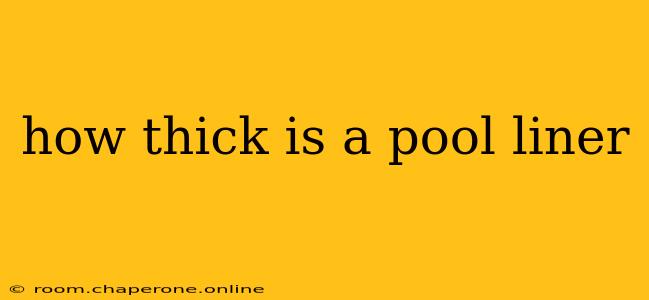Choosing the right pool liner is crucial for the longevity and enjoyment of your swimming pool. One of the most important factors to consider is the thickness of the liner. This seemingly small detail significantly impacts the liner's durability, resistance to punctures, and overall lifespan. But how thick should your pool liner be? Let's dive in.
Understanding Pool Liner Thickness: Mil Measurement
Pool liner thickness is typically measured in mils (thousandths of an inch). You'll commonly encounter liners ranging from 15 mil to 25 mil, with some specialized liners even thicker. A higher mil thickness generally translates to a more robust and longer-lasting liner.
Common Thicknesses and Their Implications:
-
15-mil liners: These are the thinnest readily available options and are often considered budget-friendly. However, they are more susceptible to punctures and tears, particularly from sharp objects or heavy use. Expect a shorter lifespan compared to thicker alternatives. Best suited for smaller, less frequently used pools.
-
20-mil liners: This is a popular mid-range option offering a good balance between cost and durability. They provide enhanced puncture resistance compared to 15-mil liners and are suitable for most residential pools. A good choice for families with moderate pool usage.
-
25-mil liners: These are the thickest standard liners available and represent the premium choice. They are significantly more resistant to punctures, tears, and general wear and tear, resulting in a much longer lifespan. The added durability justifies the higher cost, making them ideal for larger pools, heavily used pools, or those with rocky or uneven bottoms.
Factors Influencing Liner Thickness Selection
Choosing the right thickness isn't just about the number; several other factors should be considered:
1. Pool Type and Size:
Larger pools or those with complex shapes will naturally experience more stress on the liner. A thicker liner (20-mil or 25-mil) is recommended for these to mitigate the risk of damage. Smaller, simpler pools might suffice with a 15-mil liner.
2. Pool Usage:
High-frequency use, particularly with children and pets, increases the chances of liner damage. Opt for a thicker liner (20-mil or 25-mil) to withstand the added wear and tear.
3. Pool Bottom Surface:
Uneven or rocky pool bottoms pose a greater risk of liner punctures. A thicker liner is crucial in these scenarios to protect against damage from contact with sharp objects.
4. Budget:
While thicker liners are more durable and offer longer lifespans, they come with a higher price tag. Balance your budget with your needs and expected pool usage.
Beyond Thickness: Other Crucial Liner Considerations
While thickness is a key factor, remember that it's not the only aspect determining liner quality and longevity. Other crucial considerations include:
- Material: Vinyl liners are the most common, but some specialized materials offer enhanced durability and UV resistance.
- Manufacturer Reputation: Choosing a reputable manufacturer ensures quality control and potentially better warranties.
- Professional Installation: Proper installation is critical for a long-lasting liner. A poorly installed liner, even a thick one, is more prone to damage.
Conclusion: Making the Right Choice
Selecting the right pool liner thickness requires careful consideration of your specific circumstances. While a thicker liner generally translates to improved durability and longevity, it also involves a higher upfront cost. Weigh the pros and cons, factoring in pool size, usage, bottom surface, and budget to make the best decision for your needs. Investing in a quality liner is an investment in the long-term enjoyment and maintenance of your pool.

